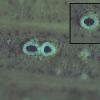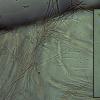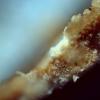
08-10-2008 20:13
Emile VandecasteeleUn de nos membres a trouvé ceci apparemment attac

03-10-2008 11:21
 Yannick Mourgues
Yannick Mourgues
Bonjour à tous. Toujours dans le but de termin

30-09-2008 13:28
 Nicolas VAN VOOREN
Nicolas VAN VOOREN
Bonjour. Trouvé ce week-end, à Saint-Jean-la-V�

29-09-2008 09:54
Tapia MikelEstamos un tanto perdidos con este pequeño ascomi

28-09-2008 20:21
Alain BRISSARDBonsoir à tous Disposant d'une documentation tro

27-09-2008 21:44
 Yannick Mourgues
Yannick Mourgues
Bonsoir à tous. / Hi everybody ! Je cher
Stictis on Bamboo sps.
Hardware Tony,
01-06-2020 16:41
 At first I felt this was edging towards S. stellata, as I understand that this is the more common in the UK on herbaceous plants stems etc. However, I finally worked out that Bamboo is a grass and with it comes another possibility. The few records I can find and in Europe is that S. arundinacea is found on grasses and with Bamboo as one of the substrates. The spores are approx 145-150 x 2, the one measured here at 137µm is short of the final pinpoint end as you will see here. So longer. The apothecial margin to me isn't star shaped and mopre enclosed and rounded. The base of the asci did not chnage colour in Iodine, which cancels out S. radiata. Paraphyses are very slender with slight swelling at ends. Wondered if anyone esle had come across this species on grasses or Bamboo.
At first I felt this was edging towards S. stellata, as I understand that this is the more common in the UK on herbaceous plants stems etc. However, I finally worked out that Bamboo is a grass and with it comes another possibility. The few records I can find and in Europe is that S. arundinacea is found on grasses and with Bamboo as one of the substrates. The spores are approx 145-150 x 2, the one measured here at 137µm is short of the final pinpoint end as you will see here. So longer. The apothecial margin to me isn't star shaped and mopre enclosed and rounded. The base of the asci did not chnage colour in Iodine, which cancels out S. radiata. Paraphyses are very slender with slight swelling at ends. Wondered if anyone esle had come across this species on grasses or Bamboo.With thanks Tony Hardware
Paul Cannon,
01-06-2020 18:18
Re : Stictis on Bamboo sps.
Hello Tony
I have material of Stictis stellata on bamboo (from Hampshire), and despite its name the ascomata are usually not noticeably stellate. You probably have either this species or S. arundinacea; the easiest way to tell between the two is to section the fruit-bodies; S. arundinacea has a wall that is at least partially dark, while in S. stellata it is ± hyaline. They both have strongly white-pruinose rims, so don't confuse this with wall tissue.
Best wishes
Paul
Hardware Tony,
01-06-2020 21:39
Paul Cannon,
04-06-2020 10:43
Re : Stictis on Bamboo sps.
I can't really tell from these images. Ideally you need to split the bamboo along the grain and then whittle away using a double-sided razor blade (with obvious attention to health and safety) to get thin sections (as thin as possible). You can either mount them in water and observe using your compound microscope, or you might just see a dark line delimiting the fruit-body (if it is there) with the high power of a dissecting microscope.
Enjoy!
Paul
Hardware Tony,
04-06-2020 12:23

Re : Stictis on Bamboo sps.
Thanks Paul. I'll try, but if you don't hear from me again then the razor slipped.
There must be easier fish to fry.
Thks again Tony
There must be easier fish to fry.
Thks again Tony
Hardware Tony,
04-06-2020 13:24

Re : Stictis on Bamboo sps.
hi Paul,
Tried my bwest here but doubt it was good enough. Shaved down very gradually and these are the three images I manged to obtain on compund microscope at 40x and 100x last one. Just looks plain whitish to me, but expect not good enough.
Placed the cut along grain slice between two pieces of bluetack! Keep it intack while I skimmed it. I might have learnt something there.
Regards Tony
Tried my bwest here but doubt it was good enough. Shaved down very gradually and these are the three images I manged to obtain on compund microscope at 40x and 100x last one. Just looks plain whitish to me, but expect not good enough.
Placed the cut along grain slice between two pieces of bluetack! Keep it intack while I skimmed it. I might have learnt something there.
Regards Tony
Paul Cannon,
05-06-2020 18:13
Re : Stictis on Bamboo sps.
Still not completely sure but S. stellata seems to be a good hypothesis for the ID.
Pual







